Coating Thickness Estimation Using a CNN-Enhanced Ultrasound Echo-Based Deconvolution
Abstract
1. Introduction
2. State of the Art
3. Proposed Modelling Approach
3.1. Model of the Reflection Response of the Medium
- Incident Wave: The transducer emits an ultrasonic pulse into the material.
- First Echo (): The pulse reaches the back surface of the material, where a greater portion of the energy is reflected back (due to impedance difference), creating the first echo.
- Subsequent Echoes (): The remaining energy of the original pulse continues to propagate through the material. With each round trip (transmit–receive cycle), additional portions of energy are reflected at the back surface, resulting in successive echoes.
- Converting these representations into the frequency domain yields:
- The transducer is inherently band-limited.
- Any type of noise present in the system is assumed to be additive.
- The incident wave is modelled as a longitudinal plane wave.
- The measurement system is assumed to be linear and time-invariant (LTI); therefore, deconvolution techniques can be applied.
- Layer 0: Couplant/Transducer
- Layer 1: Rear coating
- Layer 2: Steel
- Layer 3: Front coating
- Layer 4: Air
4. Methodology
4.1. Measurement Setup and Materials
4.2. Deconvolution Model Implementation
4.3. Synthetic Signal Generation
4.3.1. Definition of the Propagation Medium
4.3.2. Simulation Setup
4.3.3. Synthetic Signals from Simulation
4.3.4. Ground Truth Definition
4.4. CNN-Network
5. Results and Discussion
- Measurement system impulse response and experimental noise. The non-ideal response of the transducer and measurement system cannot be explicitly modelled in k-Wave. In the simulations, the excitation is defined directly as a normal stress with a temporal waveform taken from the first backwall echo of bare steel measurements (one for each steel type, S235 and S355, randomly assigned in the simulations), and spatially modulated with a Gaussian kernel to mimic a focused aperture. Since this reference signal is obtained from pulse-echo measurements in bare steel performed with the same transducer used for the coated samples, it is assumed to capture the effect of the transducer’s impulse response. However, it is not strictly representative of the actual transmitted pulse, and thus remains a simplification. Experimental noise, which refers to random fluctuations in the measurement system—e.g., electrical noise, electronic jitter, and environmental vibrations—is also present in the real signals and cannot be incorporated into the simulation.
- Frequency-dependent attenuation and dispersion. k-Wave accounts for frequency-dependent attenuation and the corresponding dispersion using a quadratic power-law model (). This corresponds to an ideal thermoviscous loss law, which does not always reflect the actual frequency-dependent absorption of real materials.
- Homogeneity and isotropy. The simulations assume constant and isotropic material properties within each layer. This is a good approximation for steel, and although the coatings are intended to be uniform, their application process may lead to small variations in homogeneity that are not captured in the model.
- 2D approximation. A 2D geometry is used primarily for computational efficiency, as full 3D simulations at the required resolution would be prohibitively expensive. The 2D assumption is a good approximation when the out-of-plane dimension is much larger than the propagation path, as in our case, where the sample thickness is small compared to its lateral area. However, 2D simulations cannot capture out-of-plane scattering, diffraction, or mode conversion, and they confine energy differently than in 3D, which may slightly alter attenuation and energy distribution.
- Single-layer coating approximation. In the simulations, the front and rear coatings were modelled as single layers. In contrast, some of the real commercial coatings consist of multiple sublayers. However, the impedance mismatch between these sublayers is assumed to be small, so the dominant contribution to reflections arises from the last sublayer adjacent to air. It is possible that these internal sublayers introduce minor reverberations or phase shifts in the ultrasonic field, but such effects have not been incorporated at this stage.
6. Conclusions and Future Work
Author Contributions
Funding
Data Availability Statement
Acknowledgments
Conflicts of Interest
Abbreviations
| NDT | Non-destructive testing |
| FDTD | Finite-difference time-domain |
| ML | Machine learning |
| DL | Deep learning |
| ToF | Time-of-flight |
| LTI | Linear and time-invariant |
| FFT | Fast Fourier transform |
| IFFT | Inverse fast Fourier transform |
| CNN | Convolutional neural network |
| UTB | Ultrasound testbed |
| GT | Ground truth |
| MSE | Mean square error |
| RMSE | Root mean square error |
| MAE | Mean absolute error |
References
- Global Wind Energy Council (GWEC). Global Offshore Wind Report. 2023. Available online: https://www.apren.pt/contents/publicationsothers/gwec-global-offshore-wind-report-2023.pdf (accessed on 4 April 2025).
- Song, G.L.; Feng, Z. Modification, degradation and evaluation of a few organic coatings for some marine applications. Corros. Mater. Degrad. 2020, 1, 408–442. [Google Scholar] [CrossRef]
- Chen, W.; Ma, L.; Li, Y.; Wu, D.; Zhou, K.; Wang, J.; Chen, Z.; Guo, X.; Li, Z.; Chowwanonthapunya, T.; et al. Prediction of coating degradation based on “Environmental Factors–Physical Property–Corrosion Failure” two-stage machine learning. npj Mater. Degrad. 2025, 9, 67. [Google Scholar] [CrossRef]
- Linshang Technology. Five Measuring Methods of Coating Thickness Gauge. Available online: https://www.linshangtech.com/tech/tech376.html (accessed on 29 August 2025).
- Aimil. The Importance of Coating Thickness Gauge in Industrial Applications. Available online: https://www.aimil.com/blog/importance-of-coating-thickness-gauge-in-industrial-applications/ (accessed on 29 August 2025).
- Living Optics. Coating Thickness Measurement. Available online: https://www.livingoptics.com/glossary/coating-thickness-measurement/ (accessed on 29 August 2025).
- Yamani, A.; Bettayeb, M.; Ghouti, L. High-order spectra-based deconvolution of ultrasonic NDT signals for defect identification. Ultrasonics 1997, 35, 525–531. [Google Scholar] [CrossRef][Green Version]
- Honarvar, F.; Tabatabai, S.; Dusatko, T.; Sinclair, A. A new signal processing technique for enhancement of ultrasonic testing signals. In Proceedings of the World Conference on NDT, Montreal, QC, Canada, 30 August–3 September 2004. [Google Scholar][Green Version]
- Shakibi, B.; Honarvar, F.; Moles, M.; Caldwell, J.; Sinclair, A.N. Resolution enhancement of ultrasonic defect signals for crack sizing. NDT E Int. 2012, 52, 37–50. [Google Scholar] [CrossRef]
- Cantero-Chinchilla, S.; Wilcox, P.D.; Croxford, A.J. Deep learning in automated ultrasonic NDE–developments, axioms and opportunities. Ndt E Int. 2022, 131, 102703. [Google Scholar] [CrossRef]
- Sendra, T.; Belanger, P. On the use of a Transformer Neural Network to deconvolve ultrasonic signals. Ultrasonics 2025, 152, 107639. [Google Scholar] [CrossRef] [PubMed]
- Niu, S.; Srivastava, V. Simulation trained CNN for accurate embedded crack length, location, and orientation prediction from ultrasound measurements. Int. J. Solids Struct. 2022, 242, 111521. [Google Scholar] [CrossRef]
- Chapon, A.; Pereira, D.; Toews, M.; Belanger, P. Deconvolution of ultrasonic signals using a convolutional neural network. Ultrasonics 2021, 111, 106312. [Google Scholar] [CrossRef] [PubMed]
- Shpigler, A.; Mor, E.; Bar-Hillel, A. Detection of overlapping ultrasonic echoes with deep neural networks. Ultrasonics 2022, 119, 106598. [Google Scholar] [CrossRef] [PubMed]
- Yamani, A. A novel defect identification scheme in ultrasonic nondestructive evaluation. Ultrasonics 1997, 35, 251–259. [Google Scholar] [CrossRef]
- Clark, G.; Tilly, D.; Cook, W. Ultrasonic signal/image restoration for quantitative NDE. NDT Int. 1986, 19, 169–176. [Google Scholar] [CrossRef]
- Rose, J.L. Reflection and Refraction. In Ultrasonic Guided Waves in Solid Media; Cambridge University Press: Cambridge, UK, 2014; pp. 53–66. [Google Scholar]
- Ginzel, E.; MacNeil, R. Impedance Matching Polymers. 2021. Available online: https://innovationpolymers.ca/wp-content/uploads/2023/09/Impedance_Matching_Polymers-202156.pdf (accessed on 1 September 2025).
- Velocity and Acoustic Impedance Table; NDT Supply.com, Inc.: Lenexa, KS, USA, 2025. Available online: https://content.ndtsupply.com/media/Velocity%20&%20Acoustic%20Impedance%20Table.pdf (accessed on 1 September 2025).
- Thibbotuwa, U.C.; Cortés, A.; Irizar, A. Ultrasound-based smart corrosion monitoring system for offshore wind turbines. Appl. Sci. 2022, 12, 808. [Google Scholar] [CrossRef]
- Olympus. Contact Transducers—Olympus-IMS.com. Available online: https://www.olympus-ims.com/en/ultrasonic-transducers/contact-transducers/#!cms[focus]=cmsContent10861 (accessed on 15 November 2021).
- Thibbotuwa, U.C.; Cortés, A.; Irizar, A. Small ultrasound-based corrosion sensor for intraday corrosion rate estimation. Sensors 2022, 22, 8451. [Google Scholar] [CrossRef] [PubMed]
- Treeby, B.E.; Cox, B.T. k-Wave: MATLAB toolbox for the simulation and reconstruction of photoacoustic wave fields. J. Biomed. Opt. 2010, 15, 021314. [Google Scholar] [CrossRef] [PubMed]
- Treeby, B.E.; Jaros, J.; Rohrbach, D.; Cox, B.T. Modelling elastic wave propagation using the k-Wave MATLAB Toolbox. In Proceedings of the 2014 IEEE International Ultrasonics Symposium, Chicago, IL, USA, 3–6 September 2014. [Google Scholar]
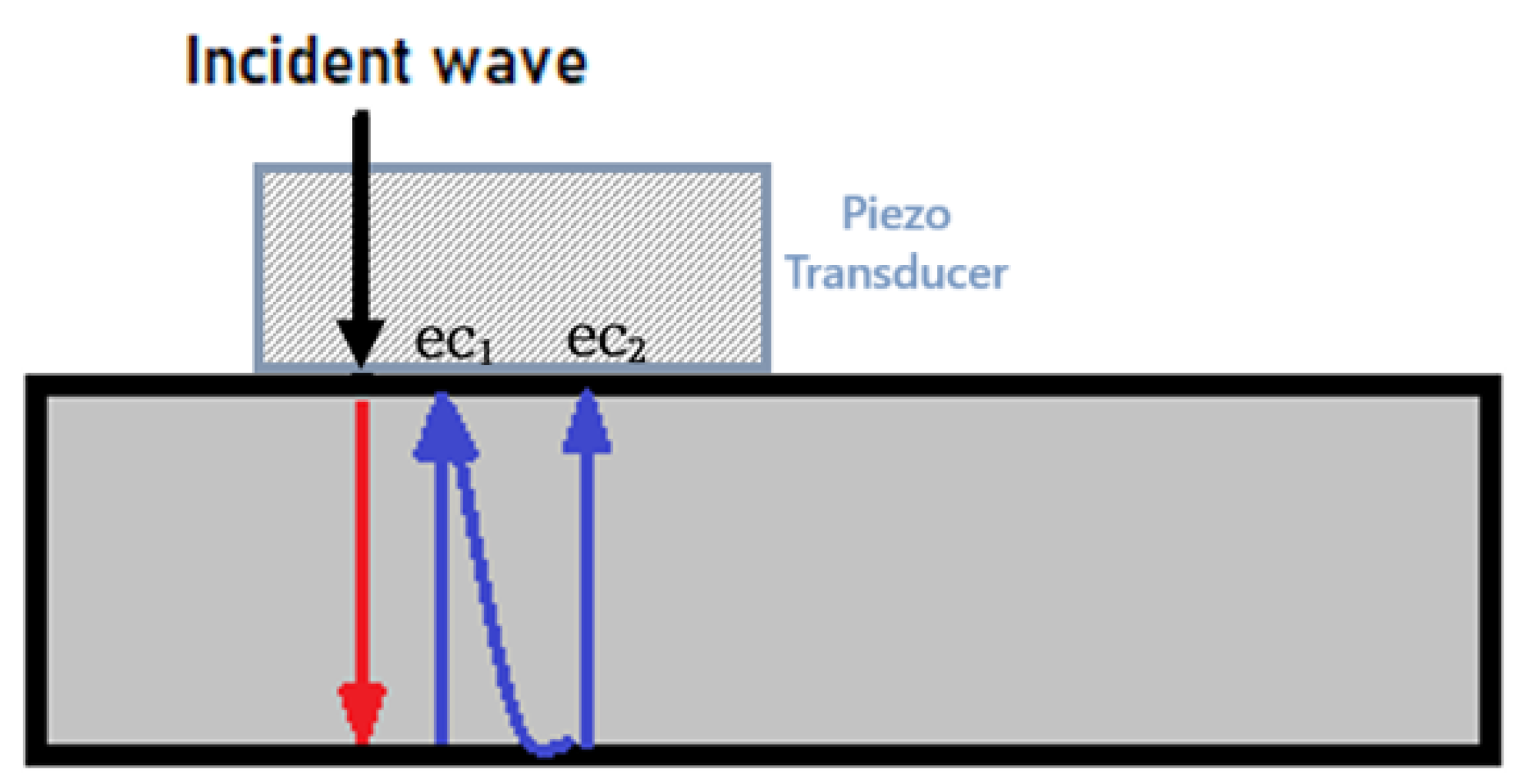

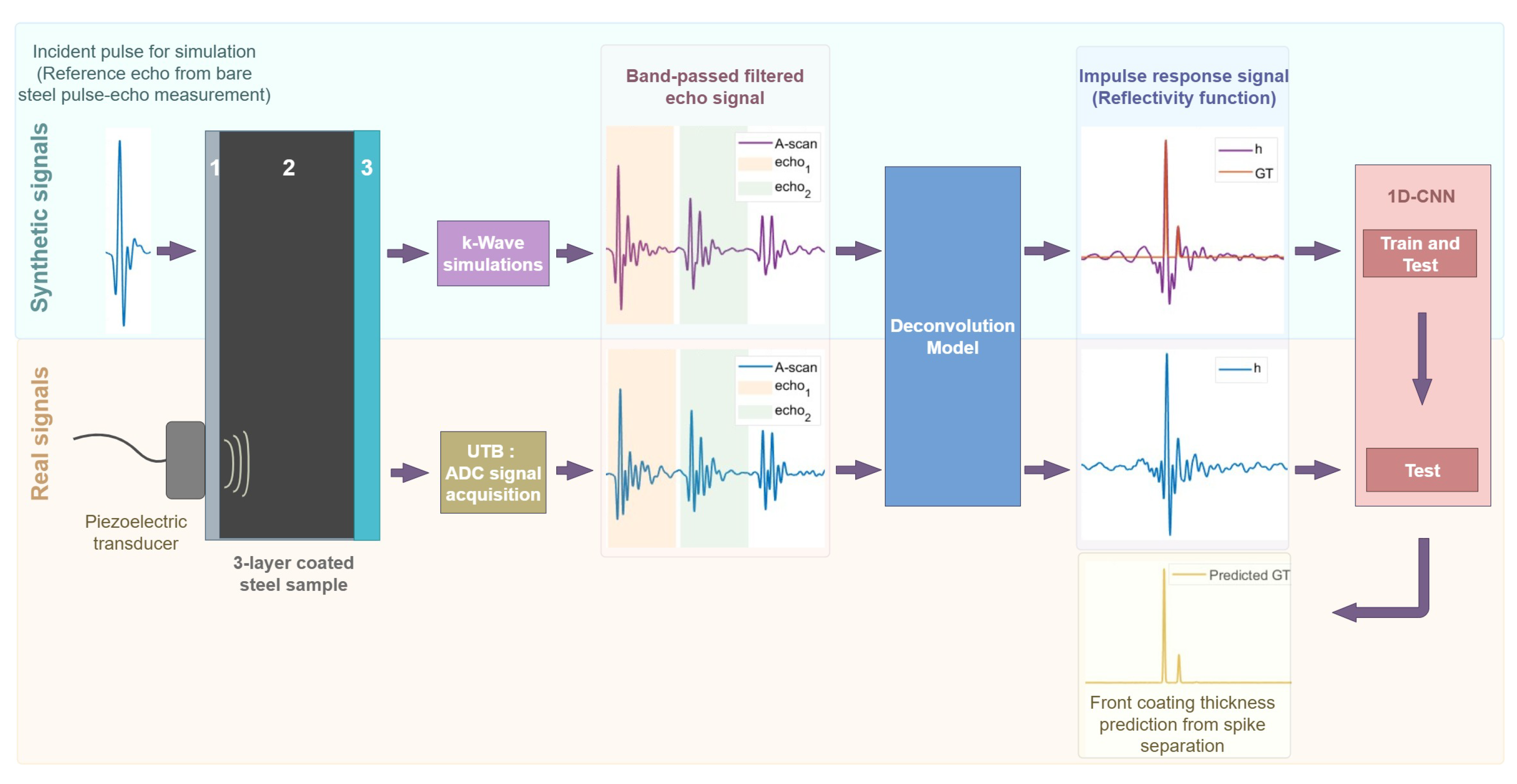

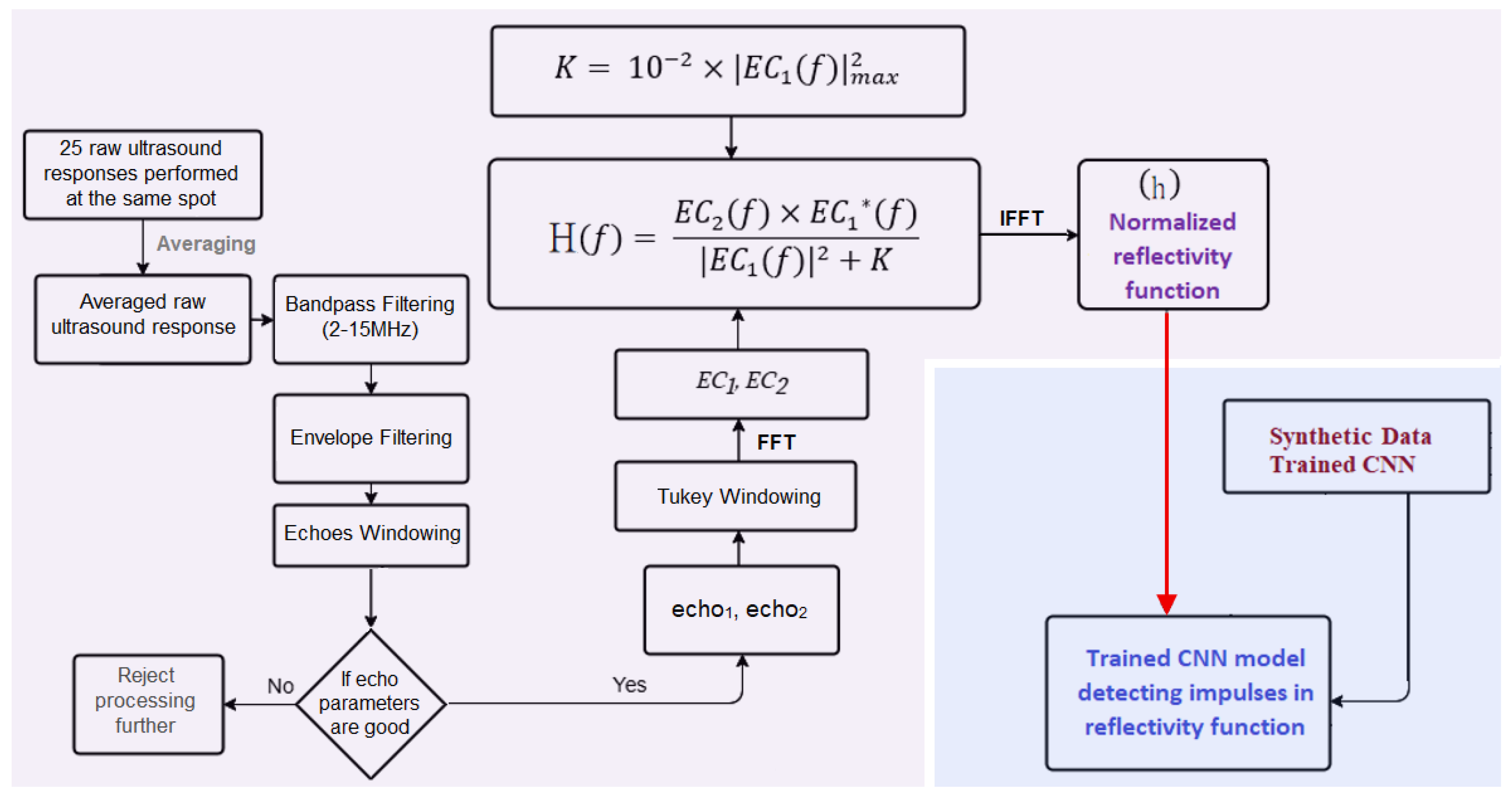

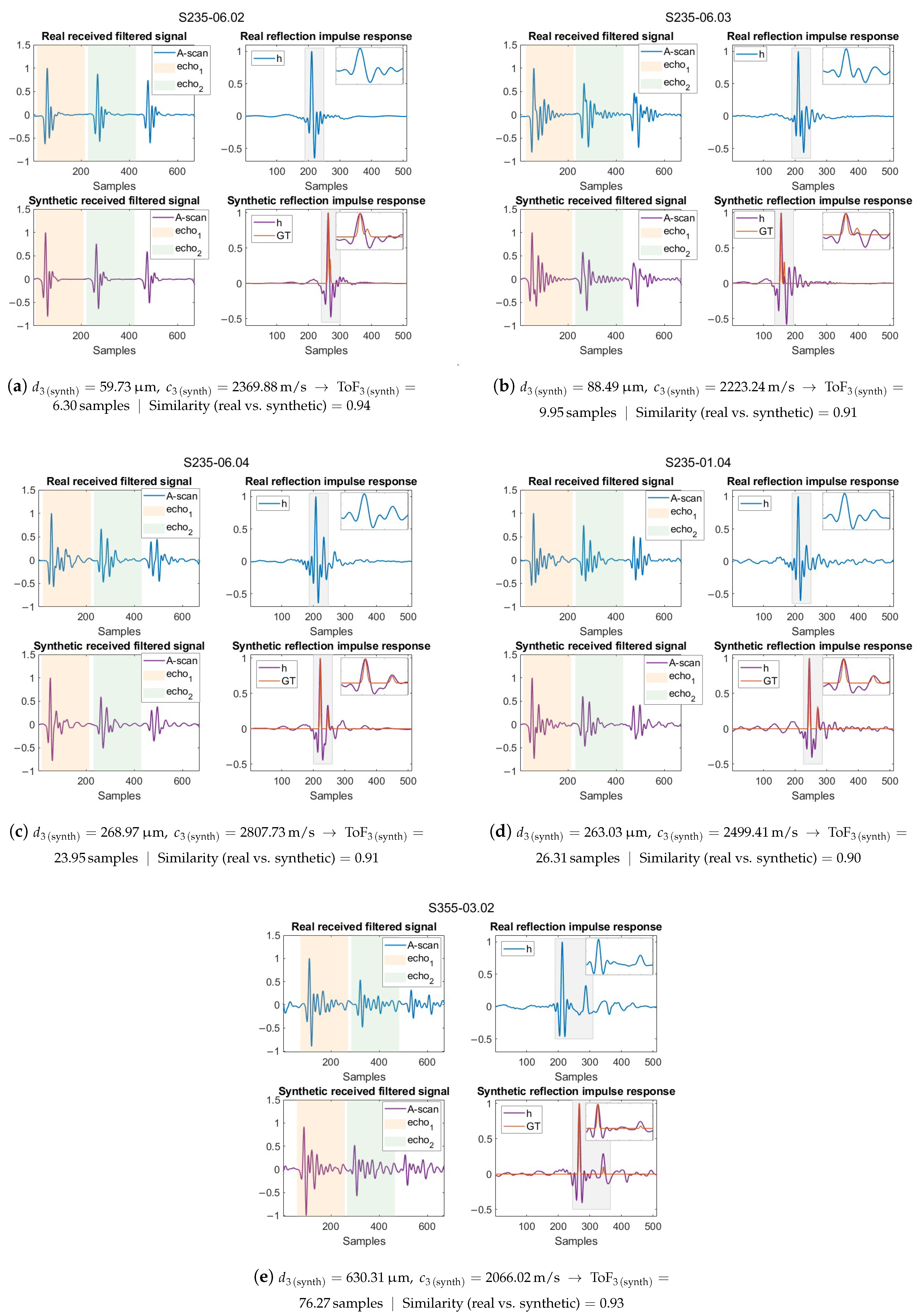
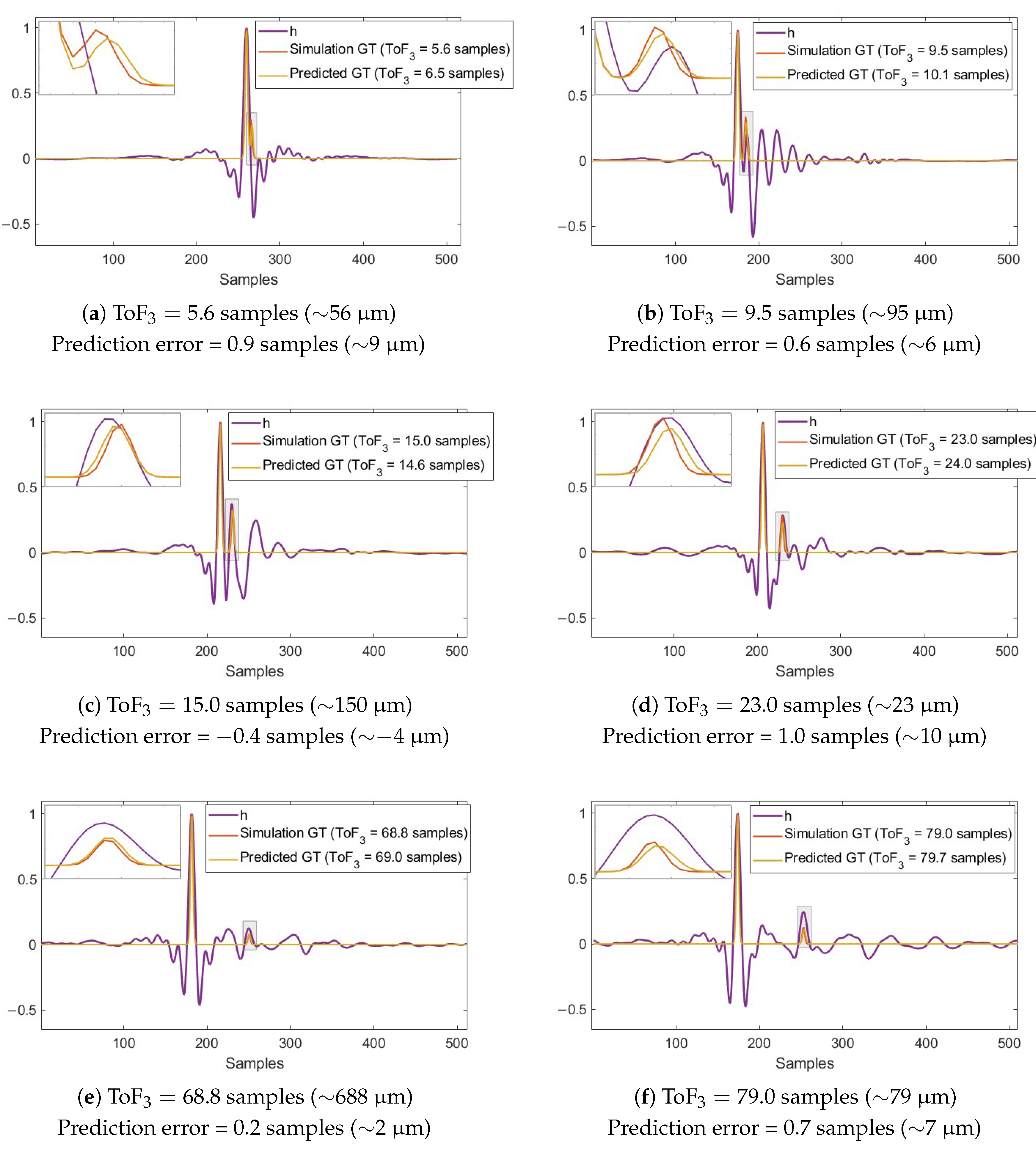
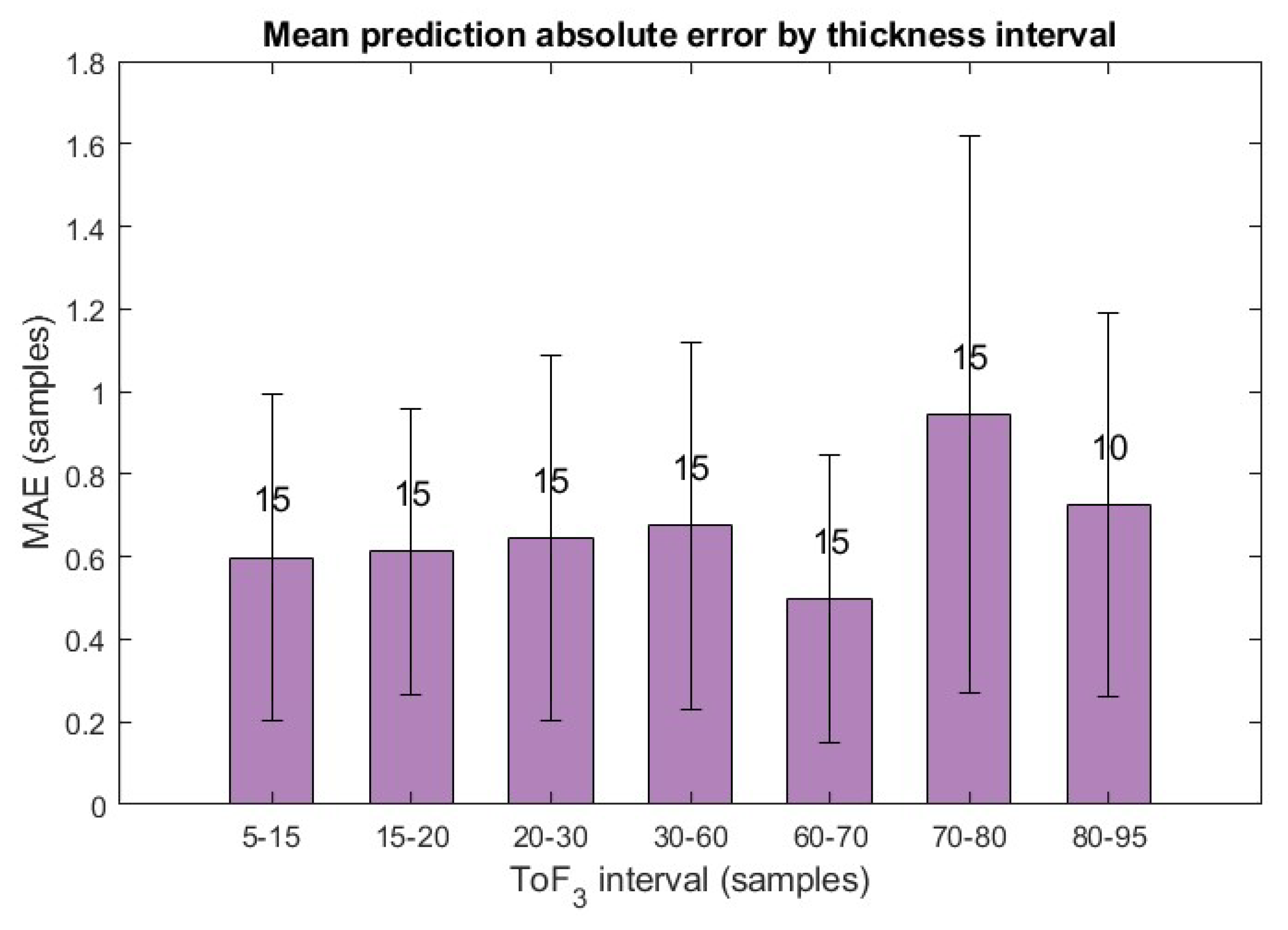

| Reflection and Transmission | ||||||
| layer | 0: Couplant/ Transducer | 1: Rear Coating | 2: Steel | 3: Front Coating | 4: Air | |
| layer | ||||||
| 0: Couplant/ Transducer | ||||||
| 1: Rear Coating | ||||||
| 2: Steel | ||||||
| 3: Front Coating | ||||||
| Sample ID | Coating Thickness | |
|---|---|---|
| Rear Side | Front Side | |
| 01.04 | Metallic 1 (∼36 m) | Multilayer: commercial product Sigmacover 1 + Sigmadur 2 (∼300 m) |
| 06.02 | Metallic 1 (∼41 m) | Metallic 1 (∼60 m) |
| 06.03 | Metallic 1 (∼41 m) | Metallic 1 (∼80 m) |
| 06.04 | Metallic 1 (∼26 m) | 3-layer coating: dimetcote 9 + sigmafast 278 + sigmadur 550 (∼278 m) |
| 03.02 | 1–2 coats epoxy (∼468–500 m) | Zn-rich primer + epoxy intermediate coat+PU coat (∼630–740 m) |
| Material | Thickness [µm] | Compressional Velocity [m/s] | Shear Velocity [m/s] | Density [kg/m3] | Compressional Attenuation [dB/(MHz2·cm)] | Shear Attenuation [dB/(MHz2·cm)] |
|---|---|---|---|---|---|---|
| Couplant | Semi-infinite | 1500 | – | 1100–1400 | 0 | – |
| Rear Coating | 20–50 (S235) 400–500 (S355) | 2000–3000 | – | 1100–2500 | 0.5–2 (S235) 0.5–2 (S355) | – |
| Steel | 5000 | 5950 | 3120 | 7850 | 0.03 | 0.05 |
| Front Coating | 50–500 (S235) 600–900 (S355) | 2000–3000 | – | 1100–2500 | 0.5–2 (S235) 0.5–2 (S355) | – |
| Air | Semi-infinite | 343 | – | 1.2 | 0.002 | – |
| MAE | Median | Std. Dev. (MAE) | RMSE | Min | Max | Skewness | Kurtosis | |
|---|---|---|---|---|---|---|---|---|
| error (samples) | 0.67 | 0.62 | 0.46 | 0.81 (8 m) | 0.02 | 2.40 | 0.85 | 3.84 |
| Sample ID | Test Piece | Bottom | Top | Nominal | ||
|---|---|---|---|---|---|---|
| Mean (Samples) | Std (Samples) | Mean (Samples) | Std (Samples) | |||
| S235-06.02 | 021 | 6.37 (∼64 m) | 0.28 (∼3 m) | 6.65 (∼67 m) | 0.09 (∼1 m) | 60 m |
| S235-06.03 | 031 | 9.43 (∼94 m) | 0.39 (∼4 m) | 9.34 (∼93 m) | 0.48 (∼5 m) | 80 m |
| 039 | 9.77 (∼98 m) | 0.59 (∼6 m) | 10.71 (∼107 m) | 1.08 (∼11 m) | ||
| S235-06.04 | 041 | 25.62 (∼256 m) | 0.32 (∼3 m) | 32.29 (∼323 m) | 0.80 (∼8 m) | 278 m |
| 042 | 36.59 (∼366 m) | 1.02 (∼10 m) | 34.06 (∼341 m) | 1.59 (∼16 m) | ||
| S235-01.04 | 04 | 25.12 (∼251 m) | 1.97 (∼20 m) | 24.90 (∼249 m) | 1.79 (∼18 m) | 300 m |
| S355-03.02 | 02 | 70.39 (∼704 m) | 0.60 (∼6 m) | 73.88 (∼739 m) | 1.45 (∼15 m) | 630–740 m |
Disclaimer/Publisher’s Note: The statements, opinions and data contained in all publications are solely those of the individual author(s) and contributor(s) and not of MDPI and/or the editor(s). MDPI and/or the editor(s) disclaim responsibility for any injury to people or property resulting from any ideas, methods, instructions or products referred to in the content. |
© 2025 by the authors. Licensee MDPI, Basel, Switzerland. This article is an open access article distributed under the terms and conditions of the Creative Commons Attribution (CC BY) license (https://creativecommons.org/licenses/by/4.0/).
Share and Cite
Perez-Diego, M.; Thibbotuwa, U.C.; Cortés, A.; Irizar, A. Coating Thickness Estimation Using a CNN-Enhanced Ultrasound Echo-Based Deconvolution. Sensors 2025, 25, 6234. https://doi.org/10.3390/s25196234
Perez-Diego M, Thibbotuwa UC, Cortés A, Irizar A. Coating Thickness Estimation Using a CNN-Enhanced Ultrasound Echo-Based Deconvolution. Sensors. 2025; 25(19):6234. https://doi.org/10.3390/s25196234
Chicago/Turabian StylePerez-Diego, Marina, Upeksha Chathurani Thibbotuwa, Ainhoa Cortés, and Andoni Irizar. 2025. "Coating Thickness Estimation Using a CNN-Enhanced Ultrasound Echo-Based Deconvolution" Sensors 25, no. 19: 6234. https://doi.org/10.3390/s25196234
APA StylePerez-Diego, M., Thibbotuwa, U. C., Cortés, A., & Irizar, A. (2025). Coating Thickness Estimation Using a CNN-Enhanced Ultrasound Echo-Based Deconvolution. Sensors, 25(19), 6234. https://doi.org/10.3390/s25196234






